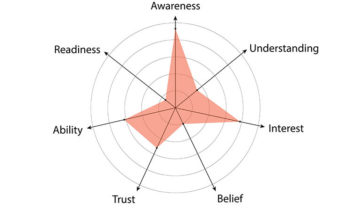The Customer Journey
The Client’s Perspective
Recently, Doug has been hammering on me about client empathy, design thinking, and the customer journey. He says whenever we offer something for purchase, the temptation is to start from ourselves and then build a bridge to those whom we think we can help.
Start from the customer you most want to serve. Work from there.
We build a phone that is light, fast, takes great pictures, and serves as a platform for a variety of powerful apps. Now our job is to market the phone. Marketing 101 tells us to segment the market — to figure out who would most likely buy the phone — then to communicate with them. We push focus group-tested hot buttons and, if we do it often enough to cut through the noise, the would-be customer is powerless to resist our pitch. We have a gizmo with certain features. Our job is to shout those attributes from the rooftop: It’s lightning fast! More pixels! Effortlessly manages ten different streams of communication! Lighter than air! Cheaper than dirt! If we hit the customer with an average of 12.7 impressions, they will march like zombies down to Verizon and buy the phone.
Doug co-teaches a design course with a member of the architecture school. He argues this kind of marketing is crazy. “Start from the customer you most want to serve. Work from there.” What are their needs? Maybe they don’t want infinite complexity in a phone but rather one that simply pulls in emails, texts and allows for quick phone calls. Maybe they intend to use the phone for gaming, and power and a large screen are paramount but weight and price are secondary.
Observing How Our Clients Buy
Armed with something that is designed to solve a set of specific problems as opposed to be the fullest manifestation of technological prowess, ask yourself, how does your customer buy? What are the stages they go through before pull the trigger on a purchase? The idea is not to “drive” them to your site but rather, to go where they naturally congregate.
In Why We Buy, Paco Underhill taught us that retailers who position their most seductive offers at the front of the store don’t understand how customers buy. Buyers walk into a store and use the front of the store to orient themselves. They can’t help it. They need to know the place is safe. Where and how many people are inside. Is it hot or cold? Are they supposed to grab a cart like when they go to the grocery store, or should they be prepared to say, “Hi,” to a greeter? Only after they have taken a few steps inside can they turn their focus to what the retailer is offering. Underhill filmed hundreds of customers and learned that most retail customers swing right as they begin to browse. They aren’t drawn to a colorful display to the left. They naturally move to the right. The lesson for the retailer? Position your best offers just to the right a half dozen steps into the store. That’s where and when customers start to pay attention. Next time you enter Target, check out the rack of magnetically placed items on the right a few strides past the double set of doors. You look at the hats and purses and seasonal baskets because that is where you want to look not because Target caused you to look there.
Doug says this is because Target has empathy for their customers. They have sought to walk a mile in their shoes before trying to sell to them. First, they sought to understand the problems customers are trying to solve and then they observed how the customer naturally shops. They started from the customer and built a bridge to their offerings. Not vice versa.
Show, Don’t Tell
Nowhere is thinking about your customer more important than when you are selling consulting or professional services. Covering up your potential clients with the features and attributes of your services just doesn’t work.
- “Smartest accountant in the tri-county region!”
- “Fastest attorney according to independent speed trials (we’re often wrong, but we’ll get you an answer in 30 minutes or less or your money back)!”
- “Cheapest logo designs on the internet. Pennies will get you a brand you will have to live with for the rest of your life!
And more impressions (Is it 7, 20, 12.4? No one really knows), only adds injury to insult. That is because consulting and professional services are sold on the three R’s:
Relationships — “I’ve worked with Jamel before. He never disappoints.”
Referrals — “I’d recommend Carolyn. She helped set up my folks’ trust and was great — smart and sensitive.”
Reputation — “I heard a cyber-security talk at the CPA convention from this guy who audits all the mid-sized firms. I think we should give him a call.”
None of this starts from the consultant or professional services provider. No one is talking about how cheap or fast someone is. All the statements start from the customer saying, “I.” They start from where the customer is when they ask one of three core questions which drive all consulting and professional services sales:
- Who have I worked with or know who might give me a hand with this?
- Who do I know who would be able to recommend someone good?
- Who is the best at this?
Doug is right when he says that no one likes to be sold to. This is doubly true in consulting and professional services. Consider the following, which I have heard from large company executives in the last twelve months:
- “It used to be all I had to read was the Harvard Business Review and the McKinsey Quarterly. Now I receive a dozen white papers each week from consulting firms. It’s overwhelming.”
- “I get invited to Fortune 500 CFO summits all the time, but it’s false advertising. It’s never CFO of companies my size. It is filled with CFO wanna-be’s, controllers or the fourth person down in the finance function at much smaller companies.”
Each of these efforts to attract clients have something in common, they start with the consultant or professional services expert at the center of their thinking.
- The supply chain expert decides to share a case study of their success in a white paper, thinking of it as a ten-page brochure for their services.
- The finance consultancy aspires to serve big company CFOs but welcomes all because, in the end, they need to justify their marketing spend on the conference.
- The IT consultant wants to walk prospective clients through her capabilities and turns to a webinar to make the sales pitch efficiently to a number of prospects.
Not one of these efforts starts from the place of where the client is in their effort to achieve their goals. They start by asking “What can I do to get the word out to the people who are best positioned to buy my services?” Not, “Who might my experience help, and how can I better understand how they perceive their challenges so I can begin to offer genuine value in advance of a sale?”




